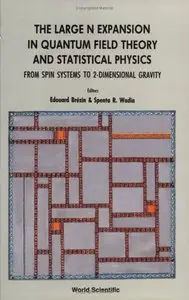E. Brezin, S.R. Wadia, "The Large N Expansion in Quantum Field Theory and Statistical Physics"
1993 | ISBN-10: 9810204558, 9810204558 | 600 pages | Djvu | 12,5 MB
1993 | ISBN-10: 9810204558, 9810204558 | 600 pages | Djvu | 12,5 MB
FOREWORD
This volume deals with the subject of the large N expansion, which has applications in quantum field theory and statistical mechanics. The subject spans over approximately 25 years and naturally falls into several eras of activity. We have included nine sections, with brief introductions and a selection of papers.
The earliest application is to spin systems where it was used to study critical phenomena. Since this method applied to any dimension of space, it was particularly useful in revealing some of the most fundamental aspects of critical phenomena.
An important step was taken by 't Hooft when he formulated the l/N expansion for S\J(N) gauge theories in perturbation theory and established a far-reaching connection with two-dimensional Riemann surfaces. This method was immediately applied to QCD in two dimensions with much success. It also provided an excellent picture of QCD dynamics in four dimensions and a framework for a synthesis of the previously unrelated ideas of strong interaction physics, namely current algebra, strong coupling theory and the nonrelativistic quark model.
The introduction of lower dimensional matrix models enabled solvability of all orders in perturbation theory and led to quantitative insights about the nature and complexity of the large N limit. These ideas foreshadowed developments in lower dimensional noncritical string theories a decade later.
One of the persistent themes in the subject has been the relation of the large N expansion of gauge theories and the string model. The Schwinger-Dyson equations provide a precise basis for such a connection. They also provide a systematic method to study other systems including spin systems. Other approaches include reduced Eguchi-Kawai models and collective field theory.
The last few years have seen exciting developments in exactly solvable models of noncritical string theories in lower dimension. This involved the application of the double scaling limit to soluble matrix models and identifying them with continuum models of lower dimensional matter coupled to gravity. This approach unveiled beautiful connections between random surfaces, integrable flows and topological field theories. However, in spite of multiple successes of the matrix model approach, we are far from an understanding of realistic string models from this viewpoint…
or from any other one at present. Deciding whether more has to be learnt from the large N limit, or whether it has said what it had to say, is left to the reader.
– Edouard Brezin Spenta R. Wadia



